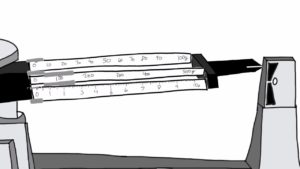This post is set up to provide support for students who are learning how to calculate density, and how to use the tools to do so.
Measuring Mass
To begin, Mark Drollinger has created a great tutorial video that teaches students how to use a triple beam balance.
Next, OHAUS Corporation has created a tutorial that allows students some minor manipulation of a virtual triple beam balance, and a simulator to practice measuring masses.
Measuring Volume
Mr. Edmonds has created a song parody (based upon “I Will Follow Him” recorded by Little Peggy March) to remind students of the importance of reading from the bottom of the meniscus when measuring the volume of a liquid in a graduated cylinder. This song starts out slow, but speeds up for the last half.
Calculating Density
To figure out how dense an object is, we first need to know its mass (how much matter, or stuff an object is made of) and its volume (how much space the object fills). Then the equation D=m/v can be used to calculate density. To remember this, I tell students to envision a bow in the shape of a capital “D”. The straight line is the string of the bow, and the curved part is the wooden portion. Next, I place two feathers and the the arrow to the right of the “D”, which looks like this: D = . Lastly, students think of cupid as the archer, and the arrow is splitting a heart into two parts. The two arches go on top which looks like an m, and the wedge goes on the bottom which looks like a v. I typically draw this out on the whiteboard. However, I found another science teacher, Sean Gillette, who approaches it the same way and has created the following digital image:
 Photo credit: Sean Gillette
Photo credit: Sean Gillette
Remembering Unit Conversions
BrainSTEM has created a short video helping students see how conversions are done. The mnemonic device that the narrator uses to remember the prefixes which go in front of the base units is: King Henry Died By Drinking Chocolate Milk. The first letter of each word, reminds people of the first word of each prefix used: kilo-, hecto- deka-, base unit, deci-, centi-, milli-.
